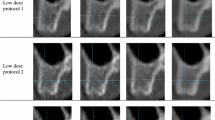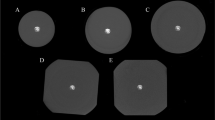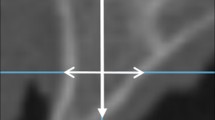Abstract
Objectives
Differences in noise and density values in MDCT images obtained using ultra-low doses with FBP, ASIR, and MBIR may possibly affect implant site density analysis. The aim of this study was to compare density and noise measurements recorded from dental implant sites using ultra-low doses combined with FBP, ASIR, and MBIR.
Methods
Cadavers were scanned using a standard protocol and four low-dose protocols. Scans were reconstructed using FBP, ASIR-50, ASIR-100, and MBIR, and either a bone or standard reconstruction kernel. Density (mean Hounsfield units [HUs]) of alveolar bone and noise levels (mean standard deviation of HUs) was recorded from all datasets and measurements were compared by paired t tests and two-way ANOVA with repeated measures.
Results
Significant differences in density and noise were found between the reference dose/FBP protocol and almost all test combinations. Maximum mean differences in HU were 178.35 (bone kernel) and 273.74 (standard kernel), and in noise, were 243.73 (bone kernel) and 153.88 (standard kernel).
Conclusions
Decreasing radiation dose increased density and noise regardless of reconstruction technique and kernel. The effect of reconstruction technique on density and noise depends on the reconstruction kernel used.
Key Points
• Ultra-low-dose MDCT protocols allowed more than 90 % reductions in dose.
• Decreasing the dose generally increased density and noise.
• Effect of IRT on density and noise varies with reconstruction kernel.
• Accuracy of low-dose protocols for interpretation of bony anatomy not known.
• Effect of low doses on accuracy of computer-aided design models unknown.
Similar content being viewed by others
Abbreviations
- ASIR:
-
Adaptive statistical iterative reconstruction
- MBIR:
-
Model-based iterative reconstruction
- FBP:
-
Filtered backprojection
References
Horner K (2013) Cone-beam computed tomography: time for an evidence-based approach. Prim Dent J 2:22–31
Nackaerts O, Maes F, Yan H, Couto Souza P, Pauwels R, Jacobs R (2011) Analysis of intensity variability in multislice and cone beam computed tomography. Clin Oral Implants Res 22:873–879
Turkyilmaz I, McGlumphy EA (2008) Influence of bone density on implant stability parameters and implant success: a retrospective clinical study. BMC Oral Health 8:32
Turkyilmaz I, McGlumphy EA (2008) Is there a lower threshold value of bone density for early loading protocols of dental implants? J Oral Rehabil 35:775–781
Ikumi N, Tsutsumi S (2005) Assessment of correlation between computerized tomography values of the bone and cutting torque values at implant placement: a clinical study. Int J Oral Maxillofac Implants 20:253–260
Merheb J, Van Assche N, Coucke W, Jacobs R, Naert I, Quirynen M (2010) Relationship between cortical bone thickness or computerized tomography-derived bone density values and implant stability. Clin Oral Implants Res 21:612–617
Aranyarachkul P, Caruso J, Gantes B et al (2005) Bone density assessments of dental implant sites: 2. Quantitative cone-beam computerized tomography. Int J Oral Maxillofac Implants 20:416–424
Isoda K, Ayukawa Y, Tsukiyama Y, Sogo M, Matsushita Y, Koyano K (2012) Relationship between the bone density estimated by cone-beam computed tomography and the primary stability of dental implants. Clin Oral Implants Res 23:832–836
Beer A, Gahleitner A, Holm A, Tschabitscher M, Homolka P (2003) Correlation of insertion torques with bone mineral density from dental quantitative CT in the mandible. Clin Oral Implants Res 14:616–620
Liang X, Lambrichts I, Sun Y et al (2010) A comparative evaluation of cone beam computed tomography (CBCT) and multi-slice CT (MSCT). Part II: On 3D model accuracy. Eur J Radiol 75:270–274
Primo B, Presotto A, de Oliveira H et al (2012) Accuracy assessment of prototypes produced using multi-slice and cone-beam computed tomography. Int J Oral Maxillofac Surg 41:1291–1295
Loubele M, Maes F, Schutyser F, Marchal G, Jacobs R, Suetens P (2006) Assessment of bone segmentation quality of cone-beam CT versus multislice spiral CT: a pilot study. Oral Surg Oral Med Oral Pathol Oral Radiol Endod 102:225–234
Mah P, Reeves TE, McDavid WD (2010) Deriving Hounsfield units using grey levels in cone beam computed tomography. Dentomaxillofac Radiol 39:323–335
United Nations Scientific Committee on the Effects of Atomic Radiation (2008) Sources and effects of ionizing radiation. Official records of the general assembly, sixty-third session, supplement No 46. United Nations, New York
Tyndall DA, Price JB, Tetradis S, Ganz SD, Hildebolt C, Scarfe WC (2012) Position statement of the American Academy of Oral and Maxillofacial Radiology on selection criteria for the use of radiology in dental implantology with emphasis on cone beam computed tomography. Oral Surg Oral Med Oral Pathol Oral Radiol 113:817–826
Cordasco G, Portelli M, Militi A et al (2013) Low-dose protocol of the spiral CT in orthodontics: comparative evaluation of entrance skin dose with traditional X-ray techniques. Prog Orthod 14:24
Jeong DK, Lee SC, Huh KH et al (2012) Comparison of effective dose for imaging of mandible between multi-detector CT and cone-beam CT. Imaging Sci Dent 42:65–70
Widmann G, Dalla Torre D, Hoermann R et al (2015) Ultralow-dose computed tomography imaging for surgery of midfacial and orbital fractures using ASIR and MBIR. Int J Oral Maxillofac Surg 44:441–446
Ludlow J, Timothy R, Walker C et al (2015) Effective dose of dental CBCT-a meta analysis of published data and additional data for nine CBCT units. Dento Maxillo Facial Radiol 44:20140197
Kyriakou Y, Kolditz D, Langner O, Krause J, Kalender W (2011) Digital volume tomography (DVT) and multislice spiral CT (MSCT): an objective examination of dose and image quality. Röfo 183:144–153
Bulla S, Blanke P, Hassepass F et al (2012) Reducing the radiation dose for low-dose CT of the paranasal sinuses using iterative reconstruction: feasibility and image quality. Eur J Radiol 81:2246–2250
Silva AC, Lawder HJ, Hara A, Kujak J, Pavlicek W (2010) Innovations in CT dose reduction strategy: application of the adaptive statistical iterative reconstruction algorithm. Am J Roentgenol 194:191–199
Molteni R (2013) Prospects and challenges of rendering tissue density in Hounsfield units for cone beam computed tomography. Oral Surg Oral Med Oral Pathol Oral Radiol 116:105–119
NIST (National Institute of Science and technology) (Last updated: May 19, 2015) Tables of x-ray mass attenuation coefficients and mass energy-absorption coefficients from 1 keV to 20 MeV for elements Z = 1 to 92 and 48 additional substances of dosimetric interest*. Available via http://www.nist.gov/pml/data/xraycoef/index.cfmJuly6th, 2015
McHanwell S, Brenner E, Chirculescu A et al (2008) The legal and ethical framework governing Body Donation in Europe - A review of current practice and recommendations for good practice. Eur J Anat 12:1–24
Riederer B, Bolt S, Brenner E et al (2012) The legal and ethical framework governing Body Donation in Europe - 1st update on current practice. Eur J Anat 16:1–21
Platzer W, Putz R, Poisel S (1978) Ein neues Konservierungs- und Aufbewahrungssystem für anatomisches Material. Acta Anat (Basel) 102:60–67
Homolka P, Gahleitner A, Kudler H, Nowotny R (2001) A simple method for estimating effective dose in dental CT. Conversion factors and calculation examples for a clinical low dose protocol. RoFo: Fortschritte auf dem Gebiete der Rontgenstrahlen und der Nuklearmedizin 173:558–562
Todisco M, Trisi P (2005) Bone mineral density and bone histomorphometry are statistically related. Int J Oral Maxillofac Implants 20:898–904
Loubele M, Van Assche N, Carpentier K et al (2008) Comparative localized linear accuracy of small-field cone-beam CT and multislice CT for alveolar bone measurements. Oral Surg Oral Med Oral Pathol Oral Radiol Endod 105:512–518
Hérin E, Gardavaud F, Chiaradia M et al (2015) Use of Model-Based Iterative Reconstruction (MBIR) in reduced-dose CT for routine follow-up of patients with malignant lymphoma: dose savings, image quality and phantom study. European radiology:1–9
Puchner SB, Ferencik M, Maurovich-Horvat P et al (2015) Iterative image reconstruction algorithms in coronary CT angiography improve the detection of lipid-core plaque–a comparison with histology. Eur Radiol 25:15–23
Hague CJ, Krowchuk N, Alhassan D et al (2014) Qualitative and quantitative assessment of smoking-related lung disease: effect of iterative reconstruction on low-dose computed tomographic examinations. J Thorac Imaging 29:350–356
Botsikas D, Stefanelli S, Boudabbous S, Toso S, Becker CD, Montet X (2014) Model-based iterative reconstruction versus adaptive statistical iterative reconstruction in low-dose abdominal CT for urolithiasis. AJR Am J Roentgenol 203:336–340
Hoxworth JM, Lal D, Fletcher GP et al (2014) Radiation dose reduction in paranasal sinus CT using model-based iterative reconstruction. AJNR Am J Neuroradiol 35:644–649
Hara AK, Paden RG, Silva AC, Kujak JL, Lawder HJ, Pavlicek W (2009) Iterative reconstruction technique for reducing body radiation dose at CT: feasibility study. Am J Roentgenol 193:764–771
Schulz B, Beeres M, Bodelle B et al (2013) Performance of iterative image reconstruction in CT of the paranasal sinuses: a phantom study. AJNR Am J Neuroradiol 34:1072–1076
Widmann G, Schullian P, Gassner E-M, Hoermann R, Bale R, Puelacher W (2015) Ultralow-dose CT of the craniofacial bone for navigated surgery using adaptive statistical iterative reconstruction and model-based iterative reconstruction: 2D and 3D image quality. Am J Roentgenol 204:563–569
Pauwels R, Silkosessak O, Jacobs R, Bogaerts R, Bosmans H, Panmekiate S (2014) A pragmatic approach to determine the optimal kVp in cone beam CT: balancing contrast-to-noise ratio and radiation dose. Dentomaxillofac Radiol 43:20140059
Van Dessel J, Huang Y, Depypere M, Rubira-Bullen I, Maes F, Jacobs R (2013) A comparative evaluation of cone beam CT and micro-CT on trabecular bone structures in the human mandible. Dentomaxillofac Radiol 42:20130145
Lekholm U (1985) Tissue-integrated prosthesis: osseointegration in clinical dentistry. Quintessence, Chicago, pp 199–209
Norton MR, Gamble C (2001) Bone classification: an objective scale of bone density using the computerized tomography scan. Clin Oral Implants Res 12:79–84
Misch CE (2008) Contemporary implant dentistry. Mosby Incorporated, St. Louis
Ericsson I, Nilner K (2002) Early functional loading using Brånemark dental implants. Int J Periodontics Restorative Dent 22:9
Al-Ekrish AA (2014) Bone quality for implants. In: Tamimi D (ed) Specialty imaging dental implants. Elsevier, Altona, pp 1/30–31/37
Homolka P, Beer A, Birkfellner W et al (2002) Bone mineral density measurement with dental quantitative CT prior to dental implant placement in cadaver mandibles: pilot study. Radiology 224:247–252
Acknowledgments
The authors wish to thank individuals who donated their bodies and tissues for the advancement of education and research. The scientific guarantor of this publication is Dr. Gerlig Widmann. The authors of this manuscript declare no relationships with any companies whose products or services may be related to the subject matter of the article. The authors state that this work has not received any funding. Amal Ahmed Gaber Abd-Alhafez, MSc (private consultant) and Eidah Alenazi, MSc (Assistant Researcher, Statistics & Operations Research Department, Kind Saud University) kindly provided statistical advice for this manuscript. Institutional review board approval was not required because the bodies used in the study were donated by people who had given their informed consent for their use for scientific and educational purposes prior to death and the study fulfilled all requirements necessary for studies on human cadavers according to the regulations of the Division of Clinical and Functional Anatomy, Medical University of Innsbruck. Written informed consent was obtained from all subjects (patients) in this study. Some study subjects or cohorts have been previously reported in the following experimental studies: Widmann G. et al., Ultralow-dose computed tomography imaging for surgery of midfacial and orbital fractures using ASIR and MBIR. International Journal of Oral and Maxillofacial Surgery. 2015. 44(4): p. 441–446, and Widmann, G. et al., Ultralow-Dose CT of the Craniofacial Bone for Navigated Surgery Using Adaptive Statistical Iterative Reconstruction and Model-Based Iterative Reconstruction: 2D and 3D Image Quality. American Journal of Roentgenology, 2015. 204(3): p. 563–569. Methodology: retrospective, experimental, multicenter study.
Author information
Authors and Affiliations
Corresponding author
Additional information
Gerlig Widmann and Asma’a A. Al-Ekrish contributed equally to this work.
Electronic supplementary material
Below is the link to the electronic supplementary material.
ESM 1
(DOCX 95 kb)
Rights and permissions
About this article
Cite this article
Widmann, G., Al-Shawaf, R., Schullian, P. et al. Effect of ultra-low doses, ASIR and MBIR on density and noise levels of MDCT images of dental implant sites. Eur Radiol 27, 2225–2234 (2017). https://doi.org/10.1007/s00330-016-4588-8
Received:
Revised:
Accepted:
Published:
Issue Date:
DOI: https://doi.org/10.1007/s00330-016-4588-8




